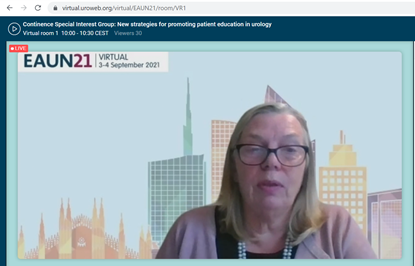New strategies in patient education on incontinence
As we waited for Thematic Session 8: Continence Special Interest Group: New strategies for promoting patient education in urology to commence, we enjoyed a special blues song on continence composed by Dr. Stefano Terzoni and sung by Ms. Elizabeth Helitzer, Music Therapist and PhD candidate from the National Rehabilitation Hospital in Ireland.
On behalf of Dr. Stefano who could not be at the EAUN21 meeting, I, together with Mrs. Virginie Lejay, chaired the session.
Our first speaker was Dr. Giulia Villa whose lecture was entitled “The lived experience of a person living with a urinary catheter”. She compared the catheter to a travelling companion and something that must always be taken with you. She discussed how a person’s life is changed as he learns to live with the unpredictability of a catheter in relation to social activities and intimacy, while learning to integrate a catheter into his daily life.
Following Dr. Villa was Ms. Veronika Geng who discussed the definition of a urinary tract infection and the difference between symptomatic and asymptomatic bacteriuria in her lecture “Urinary Tract Infection (UTI) prevention in intermittent catheterisation: Guidelines and education”. Ms. Geng also presented the factors that increase the risk of recurring urinary tract infections (rUTI). There was a good discussion on alternative methods to prevent infections, but much of the evidence is not research-based but derived from patient experience. The use of ascorbic acid, apple vinegar, ginger water, and horseradish extract, to name a few, are some of what patients may discuss with you.

In my lecture “Education in suprapubic catheter (SPC) change”, it was my pleasure to discuss and share our new animation video on changing an SPC. The learning outcomes were to apply and to integrate knowledge and skills on the practical aspect of the reinsertion and removal of an SPC.
Catheterisation is a blind procedure and it can be difficult to explain all the necessary components from aseptic non-touch technique (ANTT), insertion to removal procedures. E.g. How can we be sure that the catheter is in the bladder before inflating the balloon? A catheter should have free movement, but a simple solution is to use the transurethral catheter safety valve (TUCSV) as it leaks if the catheter is not in the bladder. Access the animation video on changing a SPC here.
Teaching patients and their families can be one of the most challenging and yet satisfying parts of providing nursing care. Education is to help improve their lives and to impart knowledge and skills to your patients. Remember, patients are often experts in their own care. They, together with family members, just need guidance by experienced urology nurses.
There is a famous quote throughout the education world by George Evans, who said, “Every child can learn. Just not on the same day or in the same way.” This quote reminds us that we are all individuals, as are our patients, and an individual approach is important.
By Ms. Eva Wallace, RN, Dept. of Urology, National Rehabilitation Hospital (IE)

